Huacas de Moche
19 September, 2007, 10:47 am in "Peru"
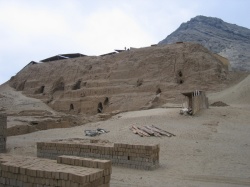 The Huacas de Moche are down a cobblestone street off of the Pan American Highway. The road leads through a quiet village. A stream/drainage ditch runs along side the road and the rushing water looks extremely picturesque. Our taxi brought us to the entrance of the Huaca de la Luna, driving past the larger Huaca de le Sol.
The Huacas de Moche are down a cobblestone street off of the Pan American Highway. The road leads through a quiet village. A stream/drainage ditch runs along side the road and the rushing water looks extremely picturesque. Our taxi brought us to the entrance of the Huaca de la Luna, driving past the larger Huaca de le Sol.From the exterior, the Huaca de la Luna looks like a large pyramidic pile of bricks with roofs covering parts, pushed up against the side of an isolated peak which rises from the desert. Dusty sand has blown up against the sides creating dunes.
Our first stop in the temple was the courtyard where the mountain made up one side and the temple the other. There was an outcropping of rocks where losing warriors were doped up on San Pedro cactus and sacrificed.
Inside the temple were walls of relief murals painted red, yellow, blue, white and black. The subjects were strange faces and stylized creatures: birds, snakes and stingrays
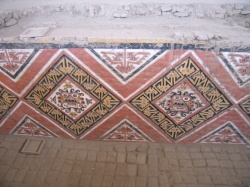 .
. The guide explained how after each high priest died, their temple was filled in with bricks and another was built on top. This preserved some of the lower layers. As archaeologists carefully uncovered each layer, all they did was preserve and conserve, not recreate. It was amazing how bright the colors had remained even after 2000 years.
The designs were fascinating-- very stylized. It must have been terrifying to be tripping on San Pedros cactus and be led into an area of strange fierce faces and designs and then be killed... although maybe for the priests it just looked really cool.
The murals of each temple changed slightly but all were strange and beautiful. It was an incredible contrast to the bleak desert.
From the top of the temple we were able to look across the ancient city of Moche
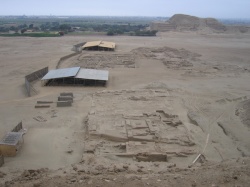 ,
, which is currently being excavated, to the Temple of the Sun. The last part had more murals including a wall of soldiers and dancers and a wall covered with many images including a scorpion, a child in an egg, a fisherman, rainbow, dogs and a multitude of other things. The guide said it may have been a calendar
 .
. After visiting the temple we walked by the ruins of the city to the base of the Temple of the Sun. It isn't being excavated at this time and I guess it isn't open. Instead we caught a very slow combi through the village. As it rolled along we were able to get a good view of the village. There were lots of restaurants but they didnt seem open. The conductor picked up a load of baskets and put them on the roof as the combi moved. One flew off into the stream next to the road so he had to chase after it and hook it with a reed he pulled from the bank. There were skinny cows, a couple pigs and fields of corn where white birds stood.
Once on the highway we picked up some speed.
Having some time to kill before our night bus to Huaraz, we headed to Huanchaco, the beach resort town on the coast. Apparently it is off season. The beaches were mostly empty except for the iconic reed fishing boats, standing up on end in the sand
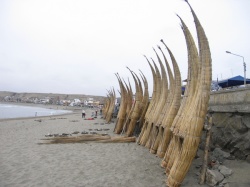 .
. There were lots of restuarants and bars but they looked mostly closed. Walking up the beach we found a dead white dolphin
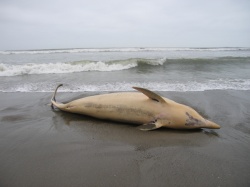 .
. From the distance I thought it was a buoy but as we got closer we could see its fins and tail so I hoped it was still alive and we could push it back into the sea and see it swim away. But it was dead. I had heard of pink dolphins in the Amazon (which are actually yellowish white) but this was salt water. I'm not sure if it was just an albino dolphin or some white dolphin species. One of the travelers we met said that in the Amazon the native people believe that the white dolphins were actually white men who became dolphins. This isn't really complimentary since apparently the pink river dolphins are considered one of the uglier species of the dolphin world.
Comments
- Comments
Powered by My Blog 1.69. Copyright 2003-2006 FuzzyMonkey.net.
Created by the scripting wizards at FuzzyMonkey.net..
(Code modified by Rowshan Dowlatabadi)
Created by the scripting wizards at FuzzyMonkey.net..
(Code modified by Rowshan Dowlatabadi)

